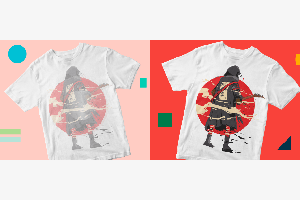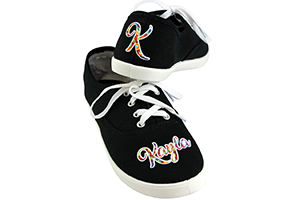October 22, 2012
If you currently are in the apparel decoration industry (or contemplating a move toward it), you probably have an interest in the concept of digital printing, as it offers multiple options for easily bringing full-color printed apparel production into any shop. Digital decorating also is an ideal solution for small runs and on-demand printing, as the setup and production is quick and simple.
To get a better understanding of the benefits of digital printing, we will take a look at two of the most popular forms used for apparel decoration: direct-to-garment (DTG) printing and dye sublimation (or sublimation, for short). Though similar in some aspects, they are quite different in others.
For the most part, a DTG printer uses a horizontally moving inkjet print head to apply an image directly onto the surface of a garment, which is mounted on a platen that gradually feeds the garment through the machine directly below the print head. Special, quick-drying inks designed specifically for the fabric being printed — typically 100% cotton — are used in the process.
Unlike screen printing, the ink colors are applied continuously in a single plane, rather than sequentially in layers. Though the inks dry when applied, they have to be cured through the use of some form of post-printing heat apparatus, such as a heat press or garment dryer.
In comparison, sublimation is a digital dye process used for printing graphic and photographic images into polymer and polyester surfaces. The inks used in the DTG process apply color to the top of the substrate’s surface, whereas sublimation dyes penetrate the surface to recolor from the inside out. Thus, the chemistry of the two processes is quite different, with sublimation relying on molecular bonding, while DTG relies on surface adhesion.
The sublimation process uses an inkjet printer equipped with sublimation dyes to print an image onto sublimation transfer paper. The printed transfer paper is then applied to the blank substrate using a heat press.
The combination of heat and pressure cause the sublimation ink to convert into a gas, which is received simultaneously by the substrate’s opened polymers. (This is an over-simplified explanation of the process, but it works for our purposes.) After the heat application is completed (about a minute), the transfer paper is removed and discarded. When the product cools down, the sublimation dye is encapsulated within the surface (instead of on top). The result is a high-resolution, permanent coloration that won’t peel or crack. And in the case of apparel, sublimation will not fade, even after multiple washings.
The limitation of sublimation is that it only works on polymer-based surfaces, which — in the case of apparel — means some form of polyester. But with the
surging demand for polyester performance apparel, sublimation is the ideal process for the product.
DIGGING IN
So that is a general overview of the two digital processes, but how do DTG and sublimation really measure up? Let’s go deeper.
Both methods use inkjet print heads to produce a printed image or graphic. In the case of DTG, the printer is either built from the ground up for the specific purpose of surface printing, or is created by modifying an existing printer system. With sublimation, off-the-shelf, office-style printers are used for desktop printing (up to about 13″ x 19″ fields) and professional printers are used for larger formats. It should be noted that no modifications are made to printers used for sublimation, and they are used right out of the box.
Inkjet print systems create image color by mixing base colors that are formulated incorporating recipes created by the graphics software. Unlike screen printing and embroidery, which use pre-colored decoration materials (ink and thread), digital printing allows you to create thousands of custom color combinations without being limited by print stations or needles.
Sublimation printers come in four-, six- and eight-color models, which refers to the number of base colors available for mixing, not the number of colors that can be output. More base colors enable the creation of more precise color detail, such as realistic facial skin tones when dealing with photographs. DTG printers are four-color units, and those capabilities are fine for most graphical applications — especially apparel.
Another key point with digital printing is that the inks and dyes will only bond with the surfaces for which they were created. DTG is primarily a cotton application, while sublimation is limited to polyester. Both will work on blended fabrics, but the colors may appear faded, muted or washed out.
With all digital printing, there is a challenge to deliver consistent color results on the final product. Both DTG and sublimation processes rely on digital artwork created with standard software programs such as CorelDRAW, or Adobe Photoshop and Illustrator. But it takes a further level of enhancement to properly deliver accurate color output at the print head.
DTG relies on raster image processor (RIP) programs that may not be included in the initial equipment purchase. Sublimation systems rely on custom printer drivers, color palettes and profiles that usually are provided by the manufacturer.
WHAT ABOUT WHITE INK?
This brings us to another important point: the effect of garment color on image color. Without a doubt, the best garment color for any printing of any kind is white. As soon as you move into anything else, the image color may be degraded. Thus, there are challenges to printing on colored garments, especially dark ones. In DTG printing, one solution is to use a chemically engineered ink called, quite simply, “white ink.”
White ink has two purposes in garment printing. It can be used as a base coat for images on colored garments and it can be used in the re-creation of the color white on colored garments.
Digital colors are created by combining different percentages of base colors (mixing). Unfortunately, the color white cannot be produced through any combination of colors; thus, white ink has to be engineered as a separate, stand-alone ink.
Because there is not a recipe for the color white, graphics programs typically leave any white areas in a design “open” under the assumption that they will be applied to a white surface. In that situation, the background color fills in the open area and creates the needed white. But if the same image was applied to a blue shirt, the supposed white areas would now be blue, which may not be ideal. With a white ink system, a command is sent to the printer telling it to apply the white ink (from an independent cartridge) when required, thus making it possible to print the color white.
The second aspect of white ink is the creation of base coats. With digital printing, you are applying a thin coating of ink or dye — meaning the colors of the ink will be intertwined with the colors of the fibers, which may affect the image color. To counter this effect, you can apply a base layer of white ink, which blocks out the background color, such that the image is actually being applied to a white background instead of directly against the color of the garment. The process sounds easy enough, but there is a lot more to this.
White ink has to be thick enough to create a decent base, yet thin enough to get through the inkjet nozzle. In addition, it has to cure quickly so that other inks can be applied on top of it without any quality issues. Chemically, it must start “drying” as soon it hits the surface of the garment.
This is accomplished by a two-pronged approach. The first is that the white ink itself must be engineered to cure quickly. The second is that a secondary chemical called a pre-treatment typically is added to the surface of the shirt before printing. When the white ink contacts the pre-treatment, the curing time is accelerated such that the production proceeds uninterrupted. This means there’s no need to stop and wait for drying to occur.
Early white ink systems developed a reputation for clogging and drying out in the print heads, which led to expensive repairs. New advances in technology have greatly improved the process and — for the most part — if you fully understand how your system works and follow the instructions provided by the manufacturer, you shouldn’t experience significant problems.
In reality, white ink is not needed on every job; thus, not all DTG printers offer it. But before you insist on having white ink capabilities, make sure you balance your desire against your need. White ink does present challenges, one of which is the artwork that has to be prepared differently to accommodate white ink. So know what you are getting into, especially since it typically raises the price tag in addition to the level of production complexity.
What about white ink for sublimation? It’s not available. There are some alternative methods, such as allover sublimation where you apply an image that completely covers the surface of a shirt. You start with a white shirt and then recolor it while adding graphics all in one step (per side). It requires a wide-format printer and heat press, but is gaining in popularity for creating retail-inspired looks for a multitude of market niches.
RANGE AND COST
Whereas DTG has the advantage over sublimation in terms of printing on colored surfaces, sublimation takes the cake when it comes to the range of products that can be decorated. Sublimation-ready merchandise includes plaques, awards, promotional products, photo panels, memorial products, signage, mugs, flip-flops, koozies, flags, tiles, iPhone covers, laptop sleeves, stadium seats, acrylics, pet products, etc. One machine can decorate hundreds of products!
Moving on to costs, both systems are close in terms of production numbers with a large, full-color image averaging about $1 in media costs. But in terms of startup costs, there are significant differences between the two. DTG printer costs start at about $16,000 and increase from there. In contrast, an entry-level desktop sublimation system starts at about $575 (without a heat press) and tops out around $2,500.
Is one system better than the other? It really comes down to your needs. Take the time to calculate the ROI for each — which goes well beyond equipment costs — as you also want to take versatility into consideration. Which process will give you the widest range of decoration services and product options based on the needs of your business? The answer to that question will generate the most business in the long run. Be diverse, creative and — most importantly — profitable!
Award-winning author and international speaker Jimmy Lamb has more than 20 years of apparel decoration experience. He currently is the manager of communication for Sawgrass Technologies, Charleston, S.C. For more information or to comment on this article, e-mail Jimmy at jlmab@sawgrassink.com.
Hear Jimmy speak on sublimation topics at the 2013 Imprinted Sportswear Shows (ISS). Individual seminars are just $25 if you pre-register: issshows.com.
April 12, 2023 | Sublimation
As you work toward becoming an experienced dye-sublimation apparel, general merch or customized promotional items decorator, you may come across one or more obstacles, like your transfers coming out blurry, dull or faded.
FULL STORY
June 1, 2022 | Sublimation
How many times have you wished that you could sublimate a product that wasn’t polymer-based or polymer-coated.
FULL STORY
October 8, 2021 | Sublimation
I think the philosophy of lagniappe should be taught at every school and practiced by every business. A French word meaning “unexpected extra gift,” lagniappe often is used in Louisiana. In fact, sublimation decoration is a fantastic example of this.
FULL STORY




